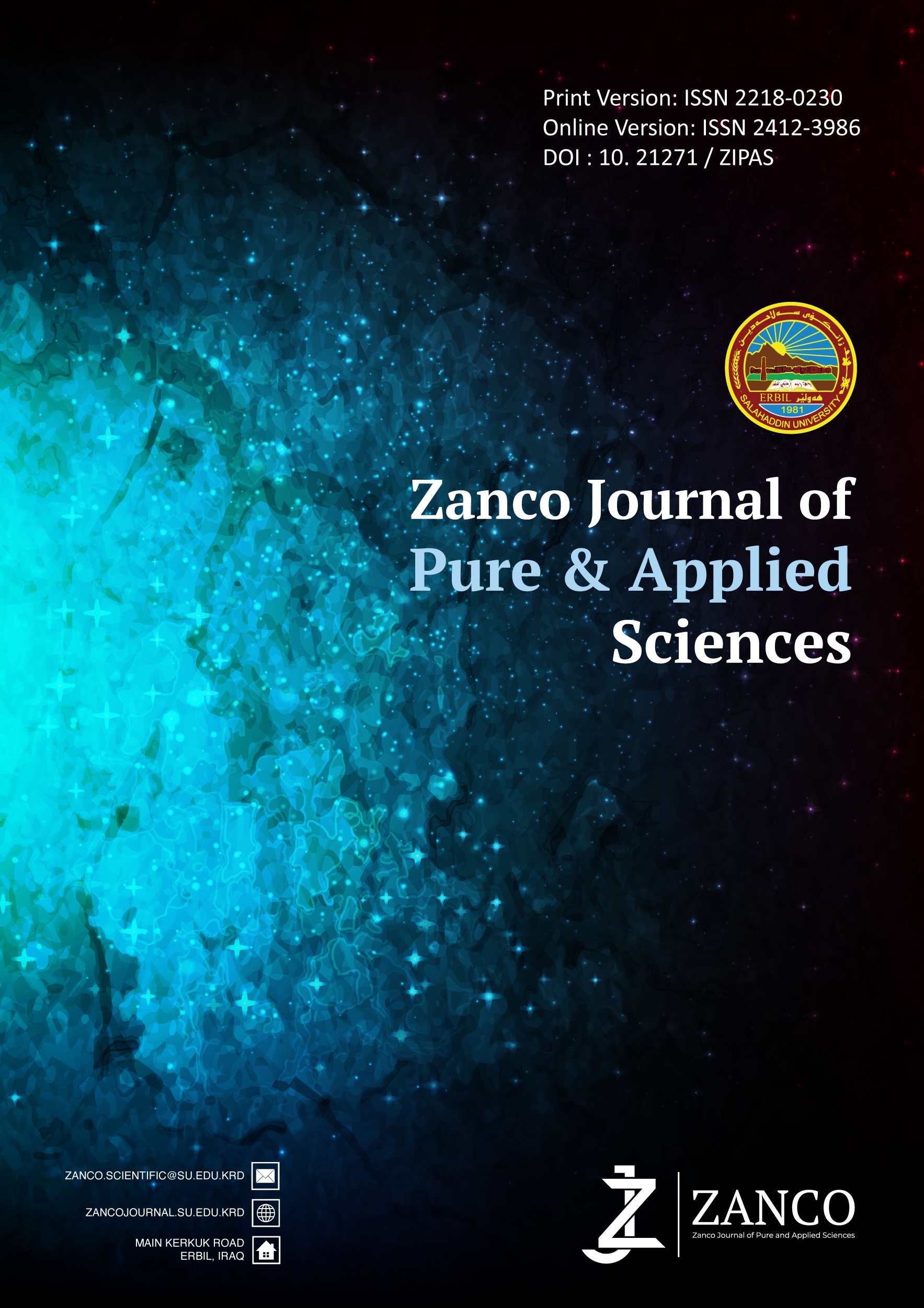Documentation of Historical City Using Oblique UAV Imagery: Case Study of the Traditional Terrace of the Jewish Neighbourhood in Akre.
DOI:
https://doi.org/10.21271/ZJPAS.36.2.4Keywords:
Documentation, UAV Photogrammetry, Oblique Images, Akre Historic city, Traditional Terrace form, Jewish Neighbourhood.Abstract
UAV photogrammetry is a crucial technique for conserving cultural heritage sites, particularly oblique images. However, studies on this method are limited. The Jewish Neighbourhood in Akre, with its significant historical and architectural value, needs urgent documentation to prevent further deformation. This article aims to present the methods and techniques of data acquisition and processing to document the traditional terrace form of the Jewish Neighbourhood. UAV was used to capture 337 images at an altitude of 40 meters with a tilted camera angle of 45 degrees. Agisoft Metashape photogrammetry software was used to process the images and produce a 3D digital surface model of the buildings, quantitative and qualitative methods were carried out to assess the accuracy of the deliverables. In addition, Global Mapper and ArcGIS software were used to drive more documentation details that would serve to set the required operational guidelines to preserve the traditional terrace form of this site. Results show that the accuracy of the produced 3D model is high and further proves that UAV photogrammetry using oblique images is an effective technique for documenting such complex historical sites.
References
AgEagle (2020). Drone flight plans: How to choose the right path. (2022). Retrieved from https://ageagle.com/blog/drone-flight-plans-how-to-choose-the-right-path/
Ahmed, S., El-Shazly, A., Abed, F., & Ahmed, W. (2022). The Influence of Flight Direction and Camera Orientation on the Quality Products of UAV-Based SfM-Photogrammetry. Applied Sciences, 12(20), 10492.
Aicardi, I.; Chiabrando, F.; Grasso, N.; Lingua, A.M.; Noardo, F.; Spanò, A. (2016). UAV Photogrammetry with Oblique Images: First Analysis on Data Acquisition and Processing. ISPRS Int. Arch. Photogramm. Remote Sens. Spat. Inf. Sci. 2016, XLI-B1, 835–842.
Alsadik, B. (2020). Crowdsource Drone Imagery – A Powerful Source for the 3D Documentation of Cultural Heritage at Risk. International Journal of Architectural Heritage. DOI: 10.1080/15583058.2020.1853851.
Azmi, Sh., Ahmed, B., Ahmed, A. (2014). Accuracy assessment of topographic mapping using UAV image integrated with satellite images. IOP Conference Series Earth and Environmental Science 18(1) DOI:10.1088/1755-1315/18/1/012015.
Chen, X. Pan, S. Chen, G. (2022). IOP Conf. Ser.: Earth Environ. Sci. 1087 012047DOI 10.1088/1755-1315/1087/1/012047.
Council of Europe. (2009). Guidance on Inventory and Documentation of the Cultural Heritage.
Duhok General Directorate of Antiquities. (2022). Information on Laser Scan and UAV Usage in Duhok and Kurdistan Region. Duhok General Directorate of Antiquities. Duhok Governorate. Kurdistan Region of Iraq.
Duhok Directorate of Constructive Planning. (2021). Archive of Masterplans of Cities in Duhok Governorate From 2013 to 2020. Duhok Directorate of Constructive Planning. Duhok Governorate. Kurdistan Region of Iraq.
Eisenbeiss, H. (2009). UAV Photogrammetry; ETH Zurich: Zurich, Switzerland.
Elkhrachy, I. (2021). Accuracy assessment of low-cost unmanned aerial vehicle (UAV) photogrammetry. Alexandria Engineering Journal, 60(6), 5579-5590.
Federman, A., Shrestha, S., Santana Quintero, M., Mezzino, D., Gregg, J., Kretz, S., & Ouimet, C. (2018). Unmanned aerial vehicles (uav) photogrammetry in the conservation of historic places: Carleton immersive media studio case studies. Drones, 2(2), 18.
Girelli, V.A., Tini M.A., & Zanutta A. (2005). Traditional and unconventional photogrammetric techniques for metrical documentation of cultural heritage: the example of the “Rolandino dei Passaggieri” Tomb (st. Domenico Square) survey in Bologna. In CIPA 2005 XX International Symposium, International Cooperation to Save the World's Cultural Heritage in Italy (pp. 310 – 315). Torino, Sergio Dequal, 26 September – 01 October.
Gerke, M & Przybilla, H (2016); Accuracy Analysis of Photogrammetric UAV Image Blocks: Influence of Onboard RTK-GNSS and Cross Flight Patterns. Photogrammetrie, Fernerkundung, Geoinformation, No. 1, 17-30.
Gerke, M. (2009). Dense matching in high resolution oblique airborne images. In U. Stilla, F. Rottensteiner, & N. Paparoditis (Eds.), CMRT09: Object extraction for 3D city models, road databases and traffic monitoring: concepts, algorithms and evaluation, Paris, 3-4 September 2009. / ed by U. Stilla, F. Rottensteiner and N. Paparoditis. ISPRS, 2009. pp 77-82 (pp. 77-82). International Society for Photogrammetry and Remote Sensing (ISPRS).
Höhle, J. (2013). Oblique aerial images and their use in cultural heritage documentation. Proc. Int. Archives of the Photogrammetry, Remote Sensing and Spatial Information Sciences, 5, W2.
Ismael, Sh. (2015). Promoting Integrated Heritage Conservation and Management in Iraqi Kurdistan Region, Applicability of Values-Based Approach; the Case Study of a Akre and Amedy city in Duhok Province.
Ismael, Sh. & Hasan B. (in press). The Role of Collaboration in Survey and Documentation of Historic Buildings. Case Study: Akre Historic Area in Kurdistan Region of Iraq. Academic Journal of Nawroz University. Impending publication.
Ismael, Sh. (2021). Using UAVs in Documenting Cultural Heritage Sites - a case study of Zakho Historic City in Kurdistan Region, Iraq. journal of Duhok University, 24(2), 12-28. https://doi.org/10.26682/sjuod.2021.24.2.2.
Jason T. Herrmann, Benjamin Glissmann, Paola Sconzo & Peter Pfälzner. (2018). Unmanned Aerial Vehicle (UAV) Survey with Commercial-Grade Instruments: A Case Study from the Eastern Ḫabur Archaeological Survey, Iraq, Journal of Field Archaeology, 43:4, 269-283, DOI: 10.1080/00934690.2018.1465808.
Kršák, B., Blišťan, P., Pauliková, A., Puškárová, P., Kovanič, Ľ., Palková, J., and Zelizňaková, V. (2016). Use of low-cost UAV photogrammetry to analyse the accuracy of a digital elevation model in a case study. Measurement, 91, 276–287. http://doi.org/10.1016/j.measurement.2016.05.028
LeBlanc, F. & Eppich, R. (2005). Documenting Our Past for the Future. The Getty Conservation Institute.
Lin, Y., Jiang, M., Yao, Y., Zhang, L., & Lin, J. (2015). Use of UAV oblique imaging for the detection of individual trees in residential environments. Urban forestry & urban greening, 14(2), 404-412.
Maiwald, F., Vietze, T., Schneider, D., Henze, F., Münster, S., & Niebling, F. (2017). Photogrammetric analysis of historical image repositories for virtual reconstruction in the field of Digital Humanities. The International Archives of the Photogrammetry, Remote Sensing and Spatial Information Sciences, XLII-2/W3, 447–452. doi:10.5194/isprs-archives-xlii-2-w3-447-2017.
Ministry of Culture and Information of the Republic of Iraq, Iraq Directorate General of Antiquities. (1970). Atlas of the Archaeological Sites in Iraq. Baghdad: al-Jumhuriya Press.
Okegbola, M. O., Okafor, S. C., Oyebanji, S. T., Raheem, G. O., & Yusuf, M. A. (2022). Assessment Of the Geometric Accuracy (Vertical and Horizontal) Of an Unmanned Aerial Vehicle Data.
Palanirajan, H. K., Alsadik, B., Nex, F., & Oude Elberink, S. (2019). Efficient flight planning for building façade 3D reconstruction. The International Archives of the Photogrammetry, Remote Sensing and Spatial Information Sciences, 42, 495-502.
Qubaa, A. R., Thannoun, R. G., & Mohammed, R. M. (2022). UAVs/drones for photogrammetry and remote sensing: Nineveh archaeological region as a case study. World Journal of Advanced Research and Reviews, 14(3), 358-368
Sanz-Ablanedo, E., Chandler, J., Rodríguez-Pérez, J., & Ordóñez, C. (2018). Accuracy of Unmanned Aerial Vehicle (UAV) and SfM Photogrammetry Survey as a Function of the Number and Location of Ground Control Points Used. Remote Sensing,10(10), 1606. MDPI AG. Retrieved from http://dx.doi.org/10.3390/rs1010160.
Sauerbier, M., & Eisenbeiss, H. (2010). UAVs for the documentation of archaeological excavations. International Archives of the Photogrammetry, Remote Sensing and Spatial Information Sciences, 38(5), 526-531.
Sarhan, H. R. & Abed, F. M. (2021). The Feasibility of Using UAV Structure from Motion Photogrammetry to Extract HBIM of the Great Ziggurat of UR. Iraqi Journal of Science, 62(11), 4518–4528. https://doi.org/10.24996/ijs.2021.62.11(SI).31.
Smith, M. J., Kokkas, N., Hamruni, A. M., Critchley, D., & Jamieson, A. (2008). Investigation into the orientation of oblique and vertical digital images. EuroCOW 2008.
Themistocleous, K. (2020). The use of UAVs for cultural heritage and archaeology. Remote Sensing for Archaeology and Cultural Landscapes: Best Practices and Perspectives Across Europe and the Middle East, 241-269.
Tommaselli, A. M. G., Galo, M., De Moraes, M. V. A., Marcato, J., Caldeira, C. R. T., Lopes, R.F., (2013). Generating Virtual Images from Oblique Frames. Remote Sensing, 5(4), pp. 1875-1893
UNESCO (2023, May 30th). About World Heritage in Iraq. Creating a digital archive of historic documents and photographs of World Heritage sites in Iraq. https://whc.unesco.org/en/canopy/digitalisation-iraq/
Wu, B., Xie, L., Hu, H., Zhu, Q., & Yau, E. (2018). Integration of aerial oblique imagery and terrestrial imagery for optimized 3D modeling in urban areas. ISPRS journal of photogrammetry and remote sensing, 139, 119-132.
Yi Lin, Miao Jiang, Yunjun Yao, Lifu Zhang, Jiayuan Lin (2015). Use of UAV oblique imaging for the detection of individual trees in residential environments, Urban Forestry & Urban Greening, Volume 14, Issue 2, 2015, Pages 404-412, ISSN 1618-8667, https://doi.org/10.1016/j.ufug.2015.03.003.
Downloads
Published
How to Cite
Issue
Section
License
Copyright (c) 2024 Shireen Younus Ismael

This work is licensed under a Creative Commons Attribution 4.0 International License.














